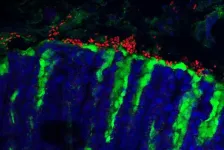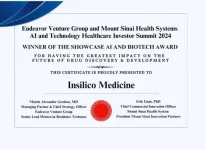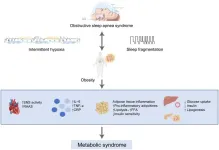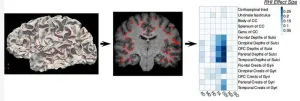(Press-News.org) A fungus discovered in the mouse stomach may hold a key to fungal evolution within the gastrointestinal tract, according to new research led by Weill Cornell Medicine investigators. The finding suggests that preclinical studies until now have overlooked a major influencer of mouse physiology.
Scientists recently have come to appreciate the importance, for human health and disease, of microbes—often called “commensals”—that naturally dwell in the gut. Bacterial commensals, for example, are known to have a big influence on human immunity; abnormal changes in these populations have been tied to cancers, inflammatory disorders and even depression. However, how gut fungal commensals affect immunity is less well understood, due in part to the lack of a good mouse model of fungal commensalism.
The new study, reported Nov. 27 in Nature, found that a yeast called Kazachstania pintolopesii, abundant in the stomach of wild mice, is exceptionally well adapted to mice and benefits them by boosting their immune protection against parasites, though it also enhances their vulnerability to some allergies.
“For years we’ve been looking for a true fungal commensal in mice, but fungal populations in lab mice, as identified by analyzing fungal DNA, tend to be transient and vary greatly from colony to colony,” said study senior author Dr. Iliyan Iliev, an associate professor of immunology in medicine, member of the Jill Roberts Institute for Research in Inflammatory Bowel Disease, and a faculty member in the Immunology & Microbial Pathogenesis Graduate School Program at Weill Cornell Medicine.
In 2019, a team led by co-author Dr. Barbara Rehermann of the National Institutes of Health found that “wildling” lab mice raised with gut microbes like those of wild mice do a better job of modeling human immune responses than traditional lab mice. Dr. Iliev’s lab, which participated in that study, found significantly higher levels of fungal DNA in the gut of these mice—magnitudes greater than previously observed in lab mice.
“This was the start of a kind of Sherlock Holmes story as we went looking for the dominant fungus, extending our study to other mouse populations,” Dr. Iliev said. “And what better place to find wild mice than New York City!”
The team looked for evidence of the fungus in fecal samples and other material provided by pest-control companies in New York City and Los Angeles, and acquired samples from multiple research institutions that use or sell lab mice. Ultimately, they determined that K. pintolopesii is very common in wild mice, but also often present in lab mouse colonies without researchers knowing about its presence.
“The presence or absence of this fungus should be taken into account in many types of mouse studies,” said co-first author Dr. Yun Liao, a postdoctoral researcher in the Iliev laboratory.
“K. pintolopesii can completely change the experimental outcome,” said co-first author Dr. Iris Gao, who was a graduate student in the Iliev lab during the study.
The researchers found that K. pintolopesii can rapidly colonize the gastrointestinal tracts of laboratory mice, is reliably transmitted to mouse newborns, and somehow evades its hosts antifungal immunity even as it partially suppresses the growth of other fungal species—all of which hints that this fungus is evolutionarily adapted for living in mice and is a true commensal.
However, upon gastrointestinal mucus fluctuations caused by dietary changes or antibiotics, for example, the fungus becomes visible to the immune system by activating the production of a cytokine called IL-33. This cytokine, in turn, triggers what is known as a “type 2” immune response. The fungus symbiotically benefits its hosts by suppressing other fungi and by protecting them against worms through this enhanced type 2 immune response, but on the flip side it exacerbates food allergies, the team discovered.
“If you’re using mice to research allergies, parasite infections, cancer development, or any other area where type 2 or type 17 immune responses are relevant, then this fungus may be an important factor that you shouldn’t omit,” Dr. Iliev said.
While the study suggests that K. pintolopesii is a good model for fungal commensalism, it also raises important questions: Is this fungus a normal component of the mouse microbiota that should always be present in lab mice, especially for studies touching on immunology? Is there a fungal commensal that has a similar role in promoting type 2 immunity in humans?
Dr. Iliev and his lab are now seeking answers to these questions in samples collected across the continent in a research collaboration formed between labs in multiple institutions including the Broad Institute, The National Institutes of Health and Penn State.
Many Weill Cornell Medicine physicians and scientists maintain relationships and collaborate with external organizations to foster scientific innovation and provide expert guidance. The institution makes these disclosures public to ensure transparency. For this information, see profile for Dr. Iliyan Iliev.
END
What a gut fungus reveals about symbiosis and allergy
2024-11-27
ELSE PRESS RELEASES FROM THIS DATE:
Insilico Medicine recognized by Endeavor Venture Group & Mount Sinai Health System with Showcase AI and Biotech Innovation Award
2024-11-27
Insilico Medicine (“Insilico”), a clinical-stage generative artificial intelligence (AI)-driven drug discovery company, is proud to be recognized for the impact on the future of drug discovery and development, as a distinguished honoree of the Showcase AI and Biotech Innovation Award on November 13, 2024, at the Fifth Endeavor Venture Group & Mount Sinai Health System Healthcare AI and Technology Investor Summit. Michelle Chen, Ph.D., Chief Business Officer of Insilico Medicine, received the award on behalf of the company.
Delivered ...
ESMO Asia Congress 2024: Event Announcement
2024-11-27
Lugano, Switzerland, 27 November 2024 – The ESMO Asia Congress 2024 is the annual event dedicated to multidisciplinary oncology in the Asian region. It will feature a broad spectrum of topics in cancer research, including novel treatment modalities, in-depth discussions on the management of specific cancer types, pan-Asian trials and subgroup analyses of cutting-edge studies relevant for the patients in the area. Data will be presented and discussed by leading experts from across Asia and beyond. The congress will be held onsite in Singapore from 6-8 December, with no virtual option available.
Programme highlights
Subgroup ...
The pathophysiological relationship and treatment progress of obstructive sleep apnea syndrome, obesity, and metabolic syndrome
2024-11-27
Cardiovascular diseases remain a leading cause of mortality globally, particularly among individuals with both obstructive sleep apnea (OSA) and metabolic syndrome (MetS). These two conditions exacerbate each other, creating a vicious cycle that increases the risk of cardiovascular diseases. Understanding the pathophysiological relationship between OSA and MetS is crucial for developing effective prevention and treatment strategies. This review explores current knowledge on the connection between OSA and MetS and discusses the progress in treatment ...
“Genetic time machine” reveals complex chimpanzee cultures
2024-11-27
Chimpanzees are known for their remarkable intelligence and use of tools, but could their cultures also evolve over time like human cultures? A new, multidisciplinary study led by the University of Zurich suggests that some of their most advanced behaviors may have been passed down and refined through generations.
In recent decades, scientists have clearly demonstrated that chimpanzees, like humans, pass on complex cultures such as tool use from generation to generation. But human culture has become vastly more sophisticated, ...
Earning money while making the power grid more stable – energy consumers have a key role in supporting grid flexibility
2024-11-27
By providing flexibility services to renewable energy systems, consumers can both help in balancing power grids and receive financial benefits. Hosna Khajeh’s doctoral dissertation from the University of Vaasa, Finland, introduces new methods that enable the efficient utilisation of energy users’ flexibility resources in distribution and transmission networks.
As the use of weather-dependent renewable energy sources increases, power systems need to become more flexible to guarantee energy supply at all times. One of the necessary steps for the future is making it possible for consumers to support both national and local power grids with ...
No ‘one size fits all’ treatment for Type 1 Diabetes, study finds
2024-11-27
Factors beyond carbohydrates have a substantial influence on blood glucose levels meaning current automated insulin delivery systems miss vital information required for glucose regulation, a new study has found.
A team of researchers from the University of Bristol analysing automated insulin delivery data from people with Type 1 Diabetes (T1D) discovered that unexpected patterns in insulin needs are just as common as well-established ones.
The study, published today in JMIRx Med aimed to identify patterns in changes of insulin needs and to analyse how frequently these occur in people with T1D who use the OpenAPS, a state-of-the-art, ...
New insights into low-temperature densification of ceria-based barrier layers for solid oxide cells
2024-11-27
Solid oxide cells (SOCs), including solid oxide fuel cells (SOFCs) and solid oxide electrolysis cells (SOECs), are among the most promising energy conversion technologies due to their high efficiency and fuel flexibility. However, the high-temperature sintering required for their manufacture often leads to undesirable reactions at the electrolyte and electrode interface, degrading cell performance. A thin, dense ceria-based barrier layer, typically composed of gadolinium-doped ceria (GDC), is widely used to prevent these reactions. Achieving sufficient densification ...
AI Safety Institute launched as Korea’s AI Research Hub
2024-11-27
The Ministry of Science and ICT (MSIT), headed by Minister Yoo Sang-im, held the launch ceremony for the "AI Safety Institute" (AISI) on Wednesday, November 27, at the Pangyo Global R&D Center.
At the "AI Seoul Summit"last May, leaders from 10 countries recognized safety as a key component of responsible AI innovation and emphasized the importance of establishing AI safety institutes and fostering global collaboration for safe AI. President Yoon Suk Yeol also expressed his commitment, stating, "We will work towards establishing an AI safety institute in Korea and actively participate ...
Air pollution linked to longer duration of long-COVID symptoms
2024-11-27
Exposure to air pollutants (PM2.5 and PM10) is associated with an increased risk of persistent long-COVID symptoms, partly due to its impact on the severity of the acute infection. This is the main conclusion of a study led by the Barcelona Institute for Global Health (ISGlobal), a centre supported by “la Caixa” Foundation, in collaboration with the Germans Trias i Pujol Research Institute (IGTP), and published in Environmental Health Perspectives.
Long-COVID is a heterogeneous condition in which symptoms like fatigue, breathlessness, and cognitive issues persist for months after ...
Soccer heading damages brain regions affected in CTE
2024-11-27
CHICAGO – Soccer heading may cause more damage to the brain than previously thought, according to a study being presented next week at the annual meeting of the Radiological Society of North America (RSNA).
Heading is a widely used technique in soccer where the players control the direction of the ball by hitting it with their head. In recent years, research has been done that suggests a link between repeated head impacts and neurodegenerative diseases, such as chronic traumatic encephalopathy (CTE).
“The potential effects of repeated head impacts in sport are ...





